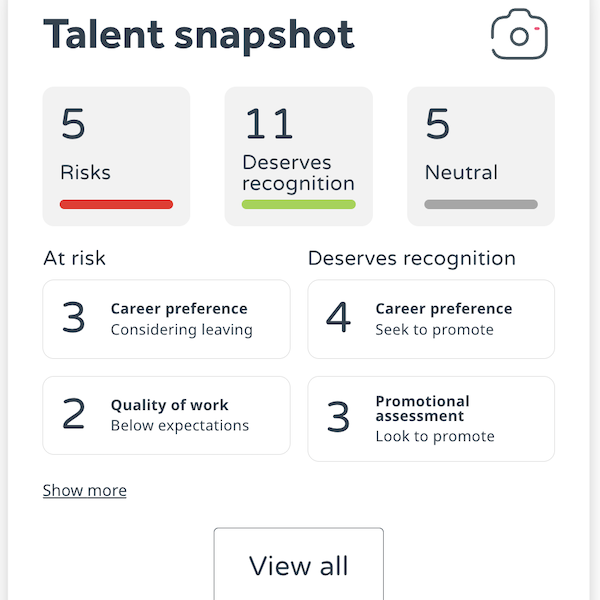A successful employee engagement survey starts with a good internal communication strategy. How you let staff know a survey is coming has a huge impact on the outcome – whether employees decide to fill it in and whether they provide honest feedback. So it’s important to get it right. Your internal comms strategy provides the opportunity to get employees excited and engaged in the process. The more transparent you are, the more trust is built and the higher the completion rate.
How should I inform employees about the survey?
Every business is different and will have their own preferred employee communication methods. At WeThrive we provide a variety of resources to help with your employee engagement survey communications, including posters, email templates and videos.
In an office, you can call a company meeting and run a video which can then be shared across online comms channels. But in retail stores where employees are offline the majority of the time, posters can have more of an impact. So think about your work environment and which methods will help communicate your message most effectively.
Manager communications
The communications plan for the survey needs to put line managers fully in the picture ahead of the staff so that they’re ready to help with any questions that staff may have.
It’s also a good idea to nominate some local champions across the business, we call them WeThrive ambassadors. Take the time to educate your champions about why you are running your employee engagement survey. They can help spread the word amongst employees on why it’s important to take part in the survey. Things won’t change unless they tell you what needs improving!
We recommend 3 stages of pre-staff survey comms:
- An initial teaser – let employees know a survey is coming soon
- Full survey comms – a formal brief with details of the survey (including what, why, when, where, how)
- Pre-survey reminder – let employees know the survey will be launching imminently so to look out for it.
How long to run the survey?
You want to give feedback as soon as possible after launching the staff survey and you can’t give any feedback until the survey is closed, so don’t keep surveys open for more than a couple of weeks.
Checklist – things to cover in your comms
1. What you’re measuring and why?
It’s important employees understand what employee engagement is and what happens when everyone is engaged at work (the positive impact of an engaged employees e.g. increased productivity, wellbeing)
Sample employee email to introduce the survey..
We as an organisation genuinely want to know what’s working and where the difficulties and frustrations are in your work. All feedback will be taken in a positive light. If you tell us openly and honestly about how work is for you we will in return do what is possible to improve in the areas that are difficult. The outcome is that you’ll have a better time at work and whole organisation will run more efficiently.
Don’t forget to inform and involve people away on holiday or maternity leave.
2. How the employee survey helps you solve challenges
Explain what measuring engagement allows the organisation to do and how the outcomes will impact employee’s own experiences at work.
Get employees excited about giving feedback! If you’ve run a staff questionnaire before, how much action did you take on the results and what impact did these actions have on employees daily working lives and also the business?
If people feel like employee opinions matter, they’ll be more inclined to keep giving it to you.
3. What you need employees to do?
You want to help people understand what measuring employee engagement will allow the organisation to do and how it will help them.
As humans we have a natural tendency towards reciprocity where we feel we need to repay others for what they have done for us.
Make it clear to all the staff that the aim is real transparency.
Let employees know it’s important they take part and share their views. The more people participate, the more representative the results and the more impact they can have. Encourage openness and get ahead of any trust issues. Otherwise, people may resist giving honest opinions for fear of retribution.
Where employee morale is low, people may resist giving honest opinions for fear of retribution. Make sure staff are aware that all employee feedback will be taken in a positive light and used to make improvements rather than point the finger/play the blame game.
4. What can employees expect in return?
Engagement surveys require give and take. If you want employees to take the time to give their feedback, they need to know what’s in it for them and that the organisation is listening.
Share the timeline for what will happen post-survey, how they will be kept in the loop and highlight the benefits of taking part to each employee.
5. Prepare employees for action
It’s important employees know that action will happen off the back of the survey. Time after time, companies ask for feedback and do nothing with it meaning employees lose trust in the process. Give employees an idea of how and when you will share the results and the plan for acting on feedback once the survey has closed.
Keep communicating once the survey is open
The communication campaign shouldn’t stop just because the survey is live. It’s important to keep informing employees of survey progress to keep the momentum going to get as many completions as possible.
There will be occasions where people lose their survey link or think they’ll come back to it but forget all about it. So it’s important to provide ongoing communications with email reminders throughout the survey to those who haven’t completed it.
For a solid communication plan, we also suggest providing a final day reminder for anyone who hasn’t got round to it to let them know it’s their final chance to have their say.
Manager feedback
Throughout the survey, involve the line managers and send them updates about completions in their team so they can personally thank staff that have completed the survey and encourage their team members that haven’t filled it out. To demonstrate a company culture of open communication managers could have short team meetings to keep everyone updated on survey completions.
Employee engagement post-survey communication
There are plenty of organisations where the next employee engagement survey is sent out before people have heard about the last survey or seen any difference from it. We recommend a three to four month survey cycle to give you enough time to feedback and learn from each survey, before starting the next employee survey.
Successful communication, with ongoing dialogue and shared employee engagement survey results is a vital part of the survey process. Where organisations are prompt and proactive about giving feedback, the organisational culture, is lifted and staff are more connected. This results in high engagement with improved employee performance and staff that are more proactive about making things better.
This initial exercise of framing the survey sets the tone for the whole cycle and also for the whole people management and Learning and Development program.
The CIPD has an employee communications factsheet and employee voice factsheet for further information.
Want to know more about running employee engagement surveys? View our webinar: ‘Eight essential steps to running a successful employee engagement survey.’





